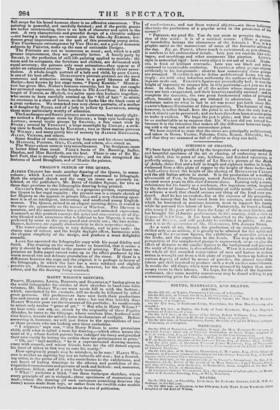SPECIMEN OF CHASING.
WE have been highly gratified by the inspection of a most extraordinary and beautiful specimen of the art or chasing, of embossing metal hi high relief, that in point of size, boldness, and finished execution, is perfectly unique. It is a model of LE Burst's picture of the Bak of Arbela, three feet and a half in length and eighteen inches in height, embossed from a thin plate of copper to the height of three inches and a half—three times the height of the chasing of BENVENUTO CELLINI and the old Italian artists in metal. It is the production of a working silversmith of Pest, in Hungary, named JOSEPH SZENLPETERY ; wife devoted seven years to this chef-irceuvre:alone. Earning only a scanty subsistence for his family as a workman, this ingenious artist, inspired by the desire of fame—" that last infirmity of noble minds "—resolved to achieve a work that should surpass any thing of the kind ever pro. duced. And he has succeeded—but at the expense of his prosperity. All the money that he had saved from his earnings, and much more which be borrowed at usurious interest, went to support his family while he pursued this labour of love. Fortunately, he found a friend, who rescued the poor artist from the fangs of the money-lenders, and has brought his elaborate !terror:nonce to this country, with a view to dispose of it for him. It bas been submitted to the Queen and the Duke of Sussex, and will probably be exhibited in public. At pre- sent it is in the possession of Mr. llEtrantoNN, 109, Jertnyn Street. As a work of art, though the production of an untaught genius, skilled only as an artisan, it is greatly to be admired for the spirit and energy of the numerous figures, the exhibition of muscular action in the limbs, and the expression in the heads. The way in which the perspective of the complicated groups is represented, so as to give the effect of distance to the smaller figures in the background and preserve
the unity of the picture, is also admirable. When it is considered that the whole of this crowded composition of men and horses in violent
action is wrought out from a thin plate of copper, beaten up hollow to various degrees of relief by means of punches, the almost incredible labour and skill requited to produce such a work excites astouishment. It recalls the old times, when men were actuated by higher than mer- cenary views in their labours. We hope, for the sake of the ingenious enthusiast, that some wealthy connoisseur may be found le illing to pay a remunerating price for this curiosity.


























 Previous page
Previous page